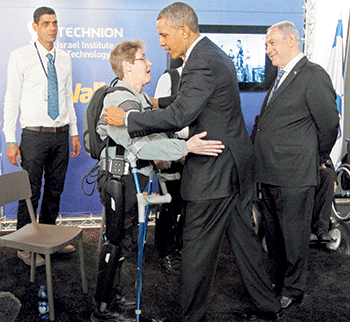If you close your eyes and listen as Theresa (Terry) Hannigan makes her way across a room, you would swear RoboCop was coming your way.
The motors that power a robotic exoskeleton kick in with a whirring sound as she takes step after step, but Hannigan is no crime fighter. She’s a middle-aged woman from Long Island whose life took a 180-degree turn for the better when she was introduced to ReWalk, the futuristic contraption that she wears and allows her to get around.
At the juncture of science and science fiction, ReWalk was designed and developed by Dr. Amit Goffer, an alumnus of the Technion – Israel Institute of Technology who became a quadriplegic after an accident in 1997.
Hannigan was in Toronto last week to demonstrate the device to Canadian supporters of the Israeli university, as well as to physicians, representatives of rehab hospitals and former Ontario lieutenant-governor David Onley, who has partial use of his legs after suffering childhood polio.
The ReWalk exo-skeleton is built and marketed by Argo Medical Technologies, headquartered in Marlborough, Mass. To date, some 150 have been used globally, mostly in the United States, Germany and Italy. One of the units is currently the subject of an investigative study at the University of Alberta.
For Hannigan, the ReWalk has been liberating. Paralyzed by an auto-immune disease she contracted while serving in the U.S. Army, she was wheelchair bound until she got a chance to try ReWalk for the first time in November 2011.
Before that, she admitted, she was depressed, worried about her future and unhappy that she was missing out on the little things in life, like taking a walk. She was also taking between 20 and 30 pills a day and suffering all the side effects of living in a wheelchair – increased skin diseases, diabetes, kidney problems, and other maladies.
ReWalk “changed my life.”
Thanks to her military service, she was able to try out the ReWalk at a Veterans Administration (VA) facility and acquire it free of charge.
The wearable robotic system consists of a backpack that houses an onboard computer and battery, plus leg braces with motion sensors powered by small motors. The whole device is controlled by a futuristic device that resembles a wristwatch. Pushing a button instructs the system to stand up, sit down or walk, using a natural gait.
On her first day trying out ReWalk, it sat her up, Hannigan recalled. Paralyzed from the chest down, with no feeling in her legs, she said it was a momentous change. “I was boo-hooing like a baby.”
Within a week of beginning her training, she could walk on her own. She can even climb stairs wearing ReWalk.
“I was doing things my doctors told me I would not be doing,” she said.
Soon, she started to feel better, both physically and psychologically.
Many of her ailments moderated. She didn’t have to inject herself with as much insulin. Her bowels functioned better. She lost 35 pounds.
And her outlook on life improved.
“I was able to be a companion to my loved ones,” she said. Until the ReWalk, the only embraces she’d get were from people putting her in and out of cars and a wheelchair. Now, “a simple hug” was within reach. She could look people in the eye when talking to them and feel better about herself.
“I can shake people’s hands, interact like a regular human being,” she said.
And she can walk alone. “I have to walk the device. It doesn’t walk me.
“It’s amazing,” she said.
Peter Escallier, vice-president of sales for Argo Medical Technologies, said the company has sold only about 200 ReWalk devices in North America, half of them last year. But the market is enormous.
In June, the U.S. Food and Drug Administration (FDA) gave its approval to market the ReWalk for home use.
“Innovative devices such as ReWalk go a long way toward helping individuals with spinal cord injuries gain some mobility,” the FDA stated in a news release. “Along with physical therapy, training and assistance from a caregiver, these individuals may be able to use these devices to walk again in their homes and in their communities.”
At a cost of $69,500 a unit, it doesn’t come cheap, but three years ago the price was more than $160,000.
Hannigan’s and Escallier’s Canadian visit was designed in part to raise ReWalk’s profile and perhaps plant the seed for wider acceptance of the device by physicians, rehabilitation facilities and insurers. The upfront cost is recouped because of savings from avoiding other serious medical consequences of immobility, Escallier said.
The company is also developing relationships with local rehabilitation hospitals to ensure that Canadians who purchase the ReWalk will get the proper training and support, he added.
Meanwhile, Goffer, the creator of the ReWalk, is working on a followup invention, a device that will help quadriplegics like himself. It’s currently in the prototype stage with, once again, the promise of a life-altering invention developed by one of the Technion’s alumni.
